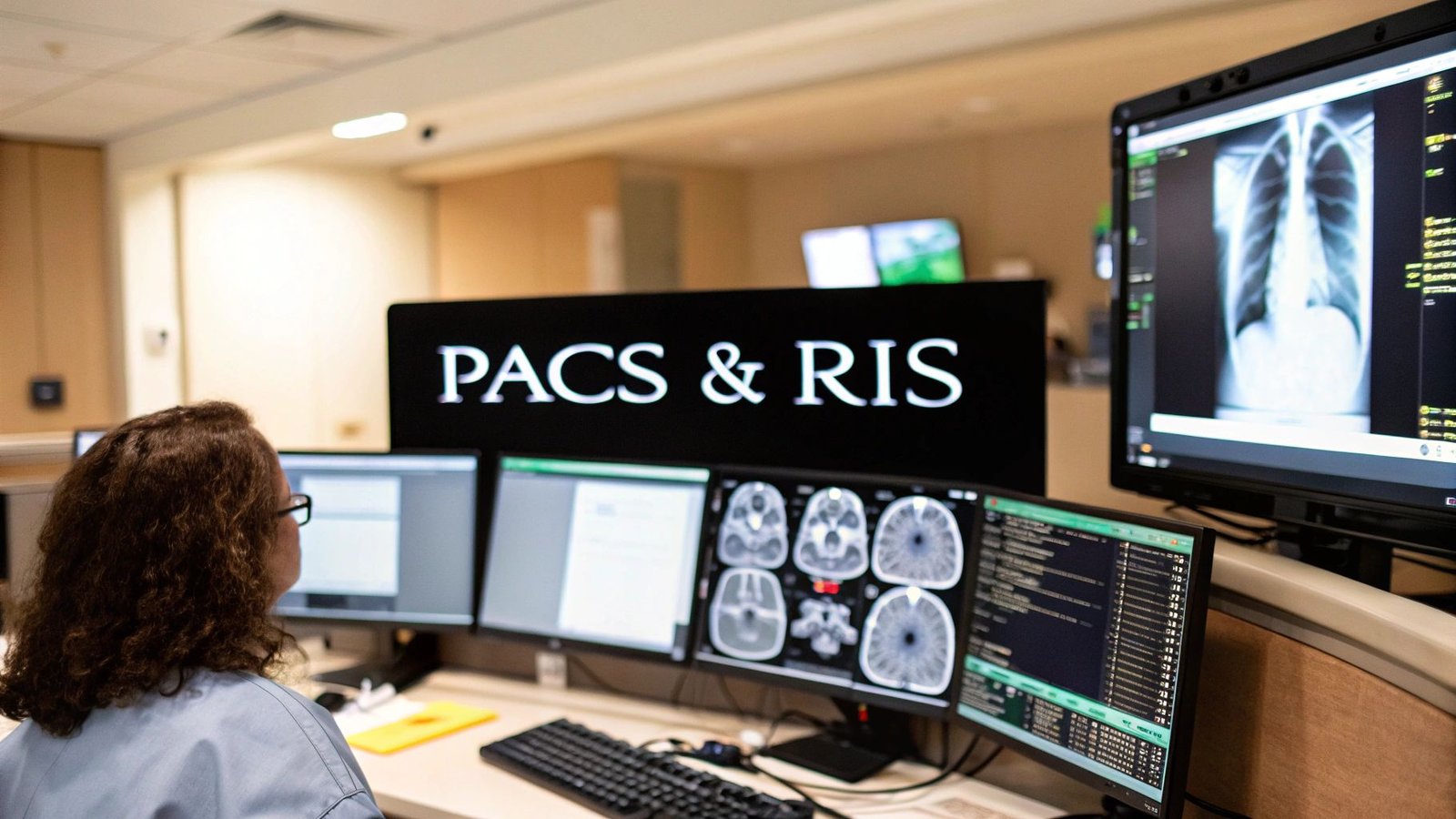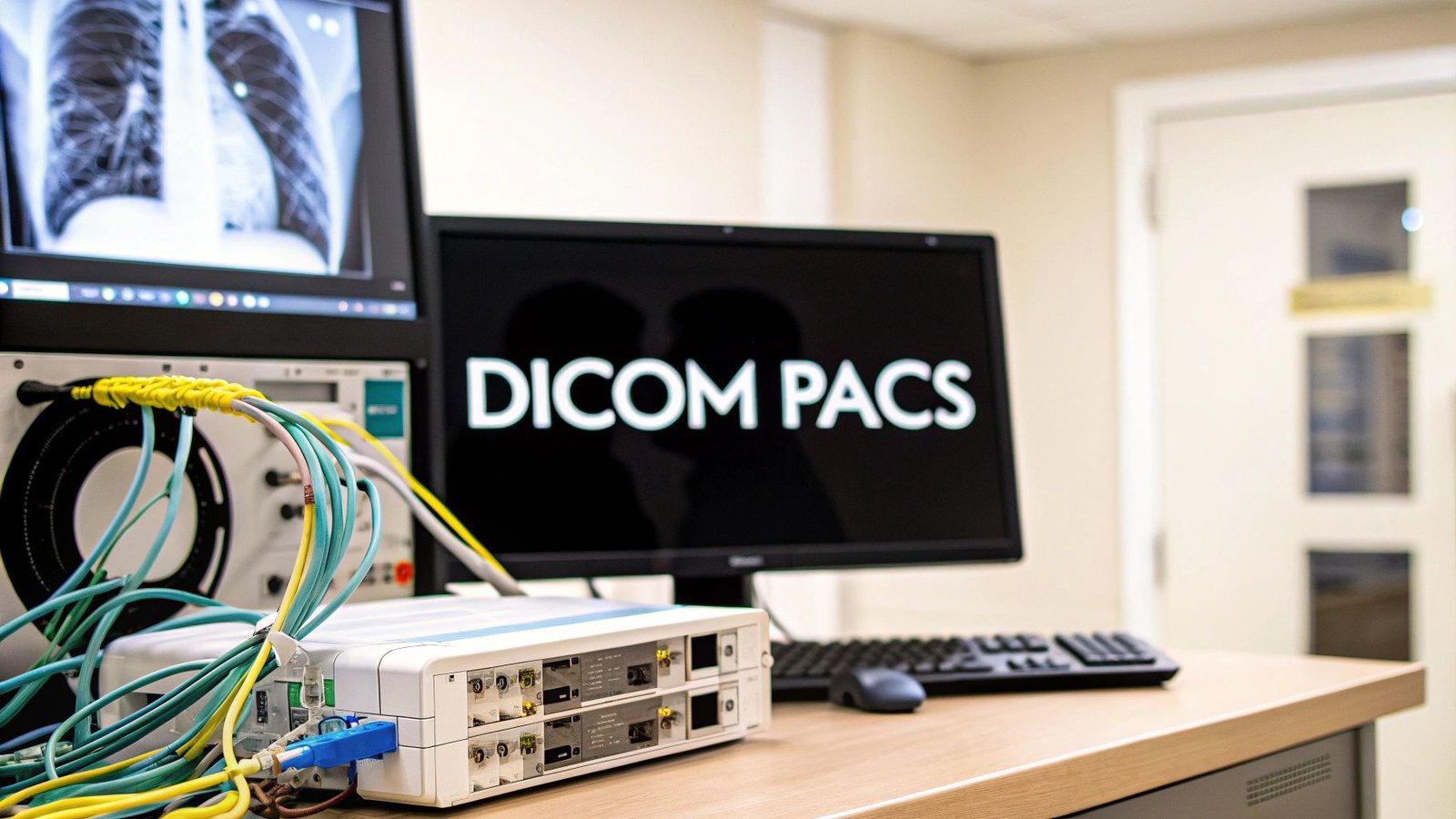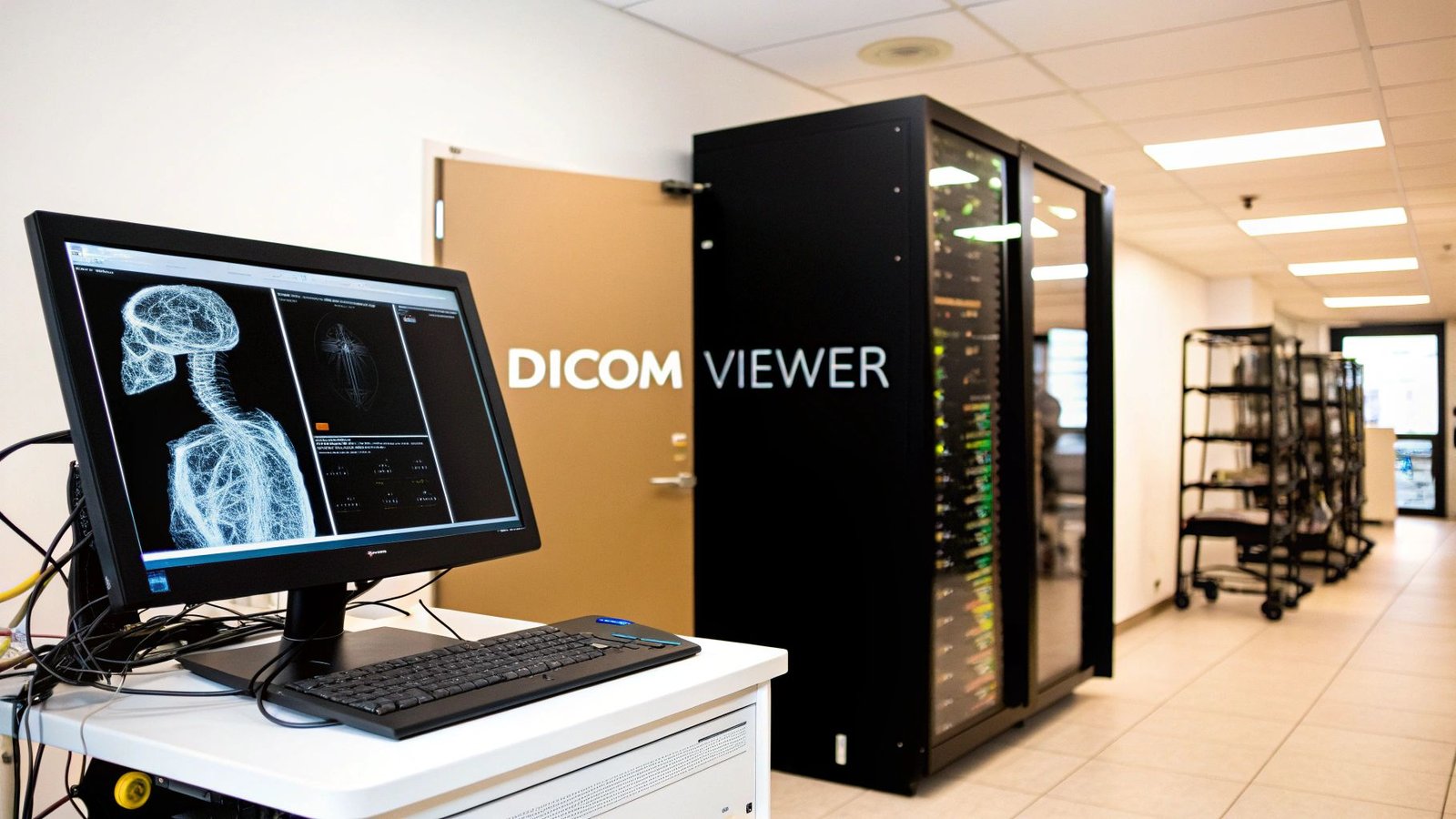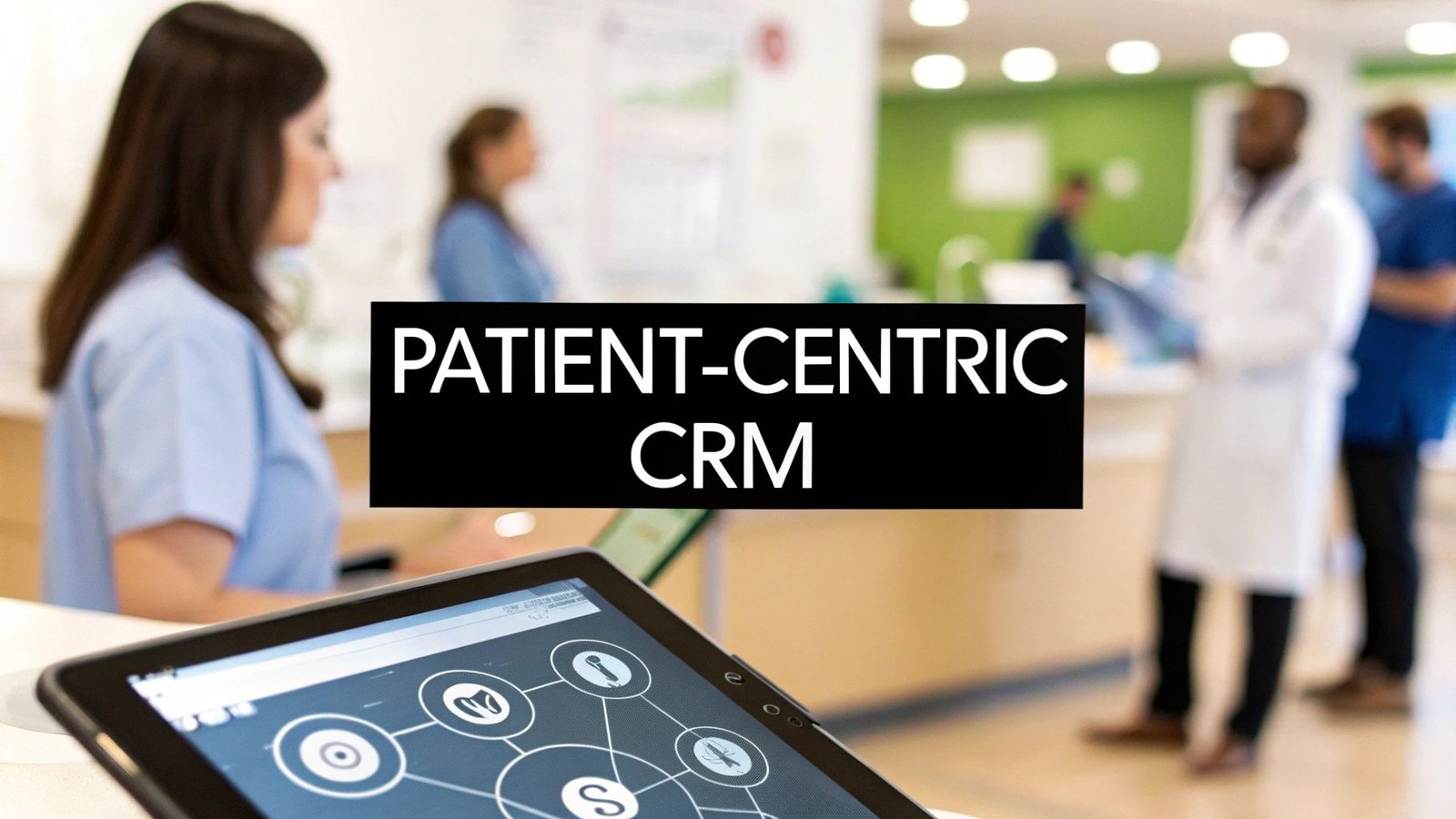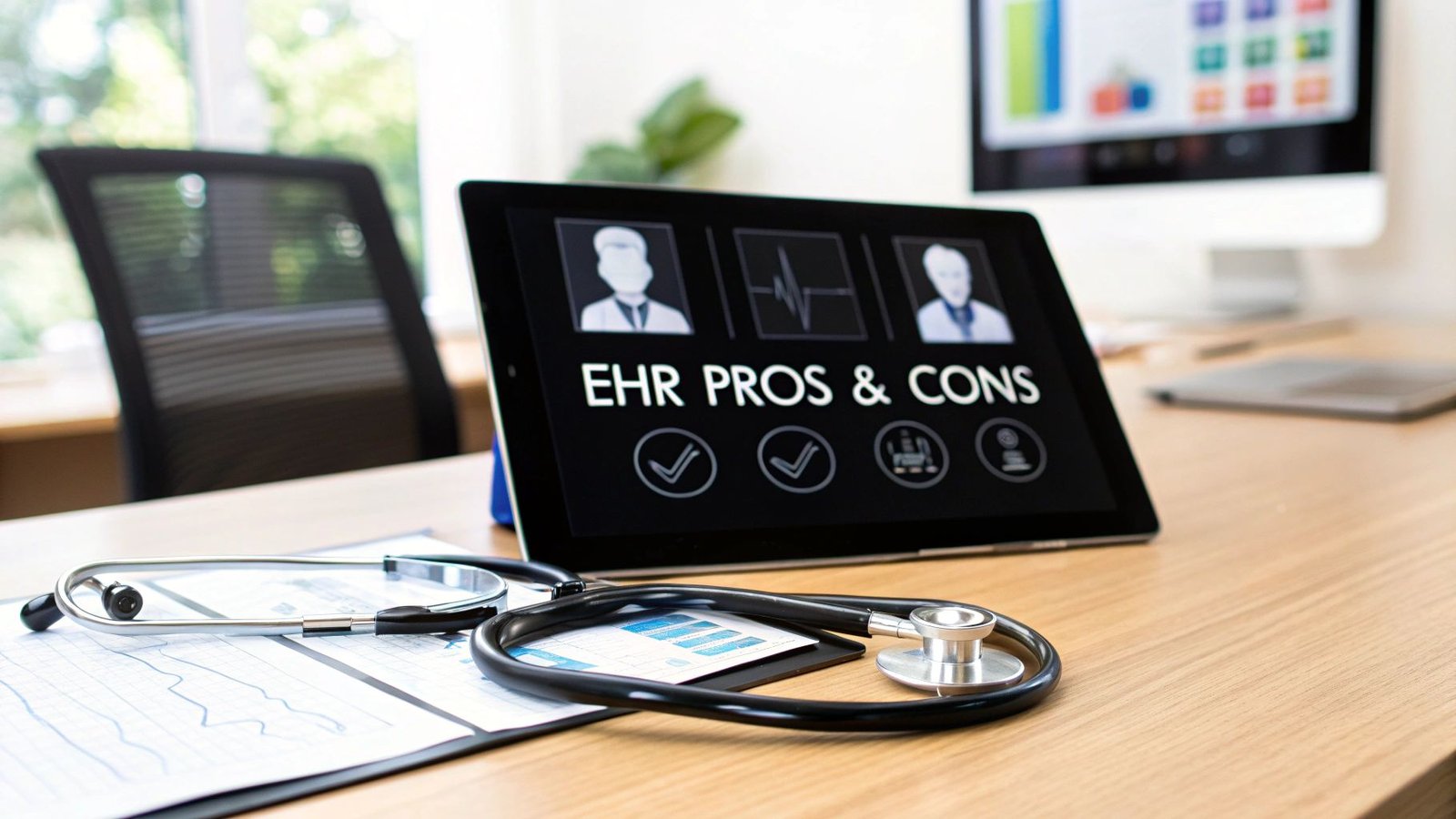Customer relationship management in healthcare is about making a fundamental shift—moving away from treating one-off appointments to truly nurturing lifelong, supportive relationships with patients. It's about using technology to see the whole person, not just the chart. The system remembers a patient's entire story—their preferences, their communication history, their feedback—and in doing so, turns the hospital from a clinical facility into a genuine partner in their health journey.
This is how you build a system on a foundation of trust, clear communication, and genuinely proactive care.
The New Heartbeat of Hospital Care
Imagine a hospital that actually anticipates your needs, communicates with you in the way you prefer, and remembers the small details from one visit to the next. This isn't some far-off future; it's what modern healthcare can be when it's powered by a new philosophy of patient engagement. We're finally moving beyond the idea of a hospital as just a place for treatment and embracing it as a collaborative partner in a patient's wellness for life.

The kind of personalized experience we've come to expect from our bank or favorite online store—where our history and preferences shape every interaction—is finally reshaping healthcare. This evolution is creating a system built on trust, open communication, and a real connection between people. It’s a crucial piece of the bigger picture, which you can explore in our guide on the https://pycad.co/digital-transformation-in-healthcare/.
From Transactions to Relationships
For decades, a hospital visit was a transaction. You received treatment, you paid a bill, and that was pretty much the end of it. A Customer Relationship Management (CRM) platform completely rewrites that script. Instead of a series of disconnected episodes, it weaves every single interaction—every call, every appointment, every question—into one continuous, cohesive story.
What does this actually look like in practice?
- Anticipating Needs: The system can intelligently flag a patient who needs a follow-up call after a tough diagnosis or automatically send helpful articles about managing a new condition.
- Personalizing Communication: If a patient prefers text message reminders, that's what they get. If another prefers a personal phone call, the system ensures that happens. It's about meeting people where they are.
- Unifying Care Teams: Everyone, from the person at the front desk to the top specialist, sees the same patient interaction history. This creates a seamless, informed experience where the patient doesn't have to repeat their story over and over.
Why This Shift Matters Now
The demand for patient-centric care has never been higher. People today see themselves as active participants in their health decisions, not passive recipients of care. To meet this expectation, hospitals have to build systems that truly support this partnership.
A hospital CRM isn't just a piece of software. It’s a strategic commitment to understanding and valuing the person behind the patient file. It’s the operational backbone that makes personalized, proactive care possible at scale.
Pulling this off requires a solid technological foundation. To really elevate the patient experience, hospitals often turn to specialized IT services tailored for Health Care to ensure their digital infrastructure is up to the task. At PYCAD, this is our world. We see the impact firsthand when we build custom web DICOM viewers and integrate them into medical imaging web platforms, directly connecting vital clinical data to the patient relationship itself.
What Is Customer Relationship Management In a Hospital?
Let's cut through the jargon and get to the heart of what customer relationship management in a hospital really means. Think of a CRM as the hospital's "relationship memory." It’s the system that helps remember the person behind the medical chart, making sure care feels coordinated, personal, and profoundly human from the very first phone call to the final follow-up.
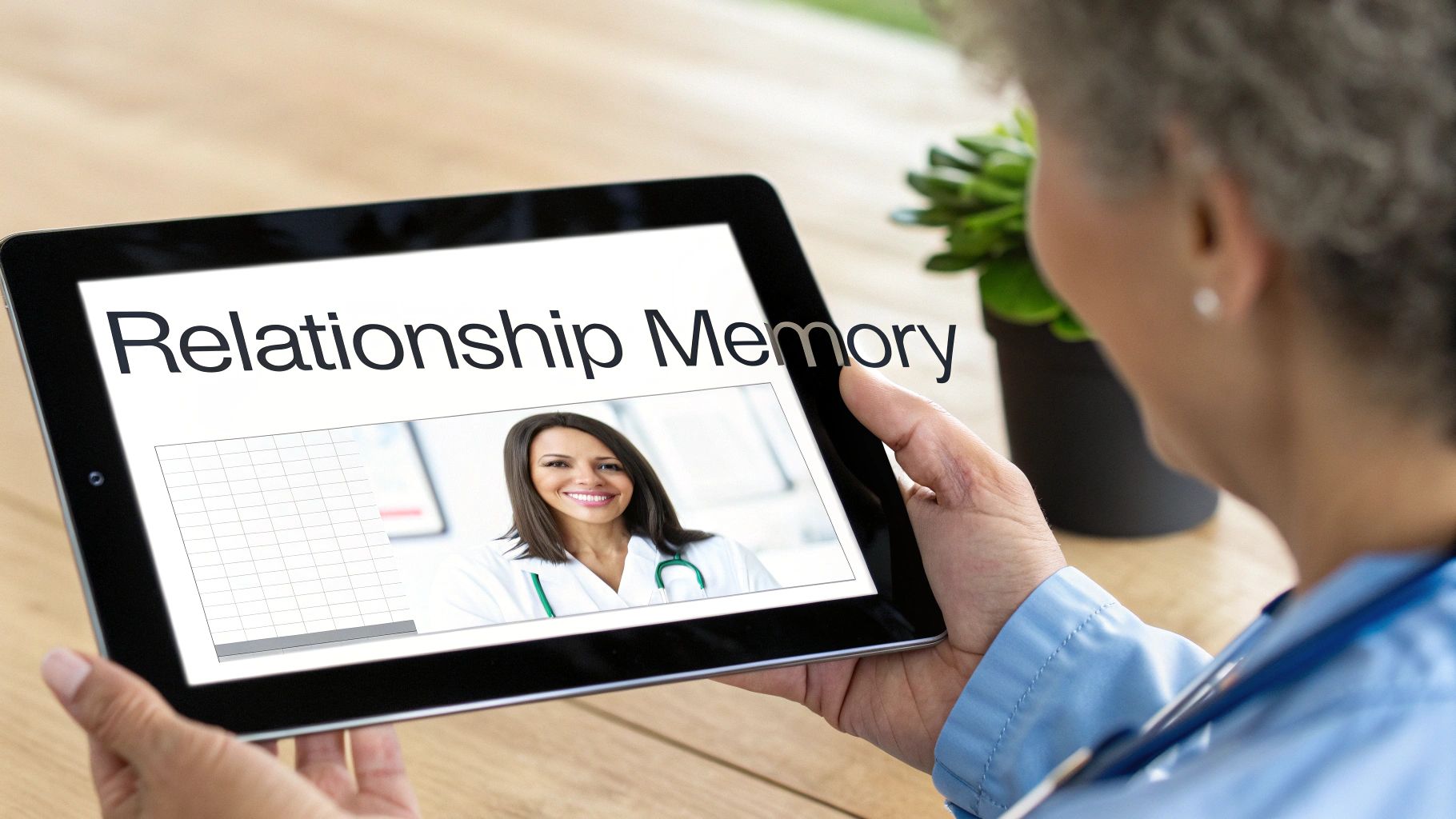
This isn't just about providing good service; it's about delivering better medicine. When a hospital sees the complete picture of a patient's journey, communication gets better, trust deepens, and care teams can finally work in sync. This holistic view is the bedrock of a modern, patient-first approach to healthcare.
The Story Keeper vs. The Health Ledger
To really get a feel for its role, you need to understand how a hospital CRM is different from an Electronic Health Record (EHR). An EHR is the clinical ledger—it meticulously tracks diagnoses, lab results, medications, and treatment plans. A CRM, on the other hand, is the patient's story keeper.
It captures the entire narrative of their relationship with the hospital system:
- Communication History: Every phone call, email, or portal message is logged, giving staff crucial context for the next conversation.
- Appointment Patterns: It tracks scheduling history, cancellations, and no-shows, which can reveal potential barriers to care.
- Patient Feedback: Surveys and comments are stored in one place, giving the hospital a direct line of sight into the patient experience.
- Engagement Touchpoints: It notes every interaction, from a visit to the hospital's website to attendance at a community wellness seminar.
This difference is everything. An EHR tells you what condition a patient has; a CRM tells you who that patient is and how they need to be cared for. In today's competitive healthcare world, this focus on the person is driving huge investments. The global healthcare CRM market, valued at around USD 17.5 billion in 2024, is expected to skyrocket to about USD 48.5 billion by 2033. This incredible growth is fueled by the demand for platforms that can deliver truly personalized care.
A hospital CRM bridges the gap between cold, hard clinical data and the warm, human experience. It ensures the hospital remembers you as a person, not just a medical record number.
To make this distinction crystal clear, here’s a simple breakdown:
Hospital CRM vs EHR: A Quick Comparison
| Feature | Hospital CRM (Relationship Focused) | EHR System (Clinical Focused) |
|---|---|---|
| Primary Goal | Manage and nurture patient relationships across their entire journey. | Document and manage all clinical aspects of patient care. |
| Data Focus | Communication history, preferences, feedback, marketing interactions. | Medical history, diagnoses, lab results, medications, treatment plans. |
| Key Users | Marketing, patient services, call centers, administration. | Doctors, nurses, clinicians, lab technicians. |
| Core Function | To create a seamless, personalized, and engaging patient experience. | To ensure accurate, secure, and efficient clinical record-keeping. |
This table shows how both systems are vital, but they serve two very different, complementary purposes. The EHR is for treating the disease; the CRM is for caring for the person.
Beyond Data: A Coordinated Journey
The real magic of a hospital CRM happens when it unifies all this relational data. It smashes the silos that often pop up between departments—admissions, billing, clinical care, and follow-up services. When every team shares a single, unified view of the patient's journey, the experience becomes smooth and connected.
This synchronized approach stops patients from feeling like they're lost in a bureaucratic maze. They no longer have to repeat their story to five different people because their entire history is visible to everyone involved in their care. Of course, the effective management of this data is crucial; for a deeper dive, check out our guide on healthcare data management.
At PYCAD, this is exactly where we live. We build custom web DICOM viewers and integrate them into medical imaging web platforms, creating a direct link between critical clinical findings and the patient's ongoing relationship with their provider. Our work is all about making sure technology serves the ultimate goal: a connected and compassionate patient experience. You can see how we bring this to life in our portfolio.
The Tools That Reshape the Patient Journey
A hospital CRM isn't just a fancy digital address book. It's the engine that powers a fundamentally better, more human patient experience. The magic isn't in the software itself, but in how its features work in concert to build a more connected, compassionate, and efficient path to wellness. Let's look at these features not as technical specs, but as the solutions they truly are.
These tools are the building blocks for a system designed to make sure no patient ever feels like just another chart number. And this idea is catching on, fast. In the United States alone, with its 6,200+ hospitals, the healthcare CRM market was valued at nearly USD 9.92 million in 2024 and is on track to more than double by 2034. This surge tells a clear story: hospitals are realizing that building strong patient relationships is the future of care. You can explore more about the U.S. healthcare CRM market to see just how significant this movement has become.
See the Whole Person, Not Just the Patient
At the very core of a great hospital CRM is the 360-degree patient view. This goes way beyond clinical data. It’s about weaving together every thread of a person's story—every interaction, preference, and concern—into a single, coherent picture.
Think about it this way: a patient calls three different times with questions about an upcoming surgery. Without a CRM, those are just three separate, forgotten calls. With a CRM, the surgeon glances at the patient's profile before the pre-op meeting and sees a note about their anxiety. That insight allows the surgeon to start the conversation by addressing those fears directly, turning a standard appointment into a moment of genuine connection and trust.
This single source of truth pulls everything together:
- Communication logs from every touchpoint, whether it's the billing office or the after-hours nurse line.
- Appointment history, including patterns like no-shows that might hint at bigger challenges like transportation issues.
- Personal preferences, like knowing they prefer a morning follow-up call or communication via email instead of text.
- Feedback and survey responses, giving you a direct line into their actual experience.
When every staff member has this context, they can engage with empathy and understanding, making the patient feel truly seen and heard.
Make Sure No One Falls Through the Cracks
One of the most powerful and immediate wins from customer relationship management in a hospital is the ability to automate communication. This isn't about being robotic; it's about being reliable. The system works tirelessly in the background to keep patients in the loop so that crucial touchpoints are never, ever missed.
Automated outreach doesn't replace the human touch—it scales it. It takes care of the routine reminders and follow-ups, freeing up your clinical teams to have the meaningful, high-impact conversations that truly matter.
For instance, a CRM can automatically:
- Send personalized appointment reminders, a simple step that has been shown to slash no-show rates by up to 30%.
- Deliver post-discharge instructions and check-in surveys to make sure a patient's recovery is on track.
- Share relevant wellness tips, like flu shot reminders or diabetes management resources, with the specific patient groups who need them most.
This steady, helpful communication reinforces the hospital's role as a lifelong partner in health, building a bond that lasts long after a single hospital stay.
Streamline Your Workflow to Focus on Care
A hospital CRM is also a game-changer for your internal teams. By automating tedious administrative tasks and smoothing out communication between departments, it gives your clinicians and staff their most valuable resource back: time to spend with patients.
Imagine the old way of scheduling a complex series of diagnostic tests—a chaotic mess of phone tag, faxes, and sticky notes between departments. A CRM can orchestrate this entire process, coordinating schedules across radiology, labs, and specialists with just a few clicks. It can even figure out the best sequence of appointments to minimize a patient's time spent waiting around the hospital.
At PYCAD, we live and breathe this kind of integration. We build custom web DICOM viewers and integrate them into medical imaging web platforms, creating a seamless link between a patient's diagnostic images and their complete profile in the CRM. This ensures clinical insights are available and actionable in an instant. You can see some of our work in our portfolio. By clearing away the administrative clutter, a CRM helps create a more responsive, efficient, and caring environment for everyone.
A Strategic Blueprint for CRM Implementation
Bringing a CRM into your hospital isn’t just another IT project. It’s a genuine shift in your organization's culture, a shared promise to put patients at the very heart of everything you do. Think of it as a journey—one that, when navigated with a clear vision, can empower your entire team to deliver a truly exceptional standard of care. This is your roadmap, designed to frame the process not as a technical chore, but as an inspiring mission that everyone can rally behind.
Laying the Foundation with Clear Goals
Before you even think about vendors or code, the journey has to start with a simple question: "What are we really trying to accomplish here?" The most successful CRM projects are always powered by clear, measurable, and patient-focused goals. These objectives become your North Star, guiding every single decision you make.
Forget vague ideas like "improving patient satisfaction." Instead, aim for concrete targets. Your goals could be:
- Cutting patient no-show rates by 20% in the first year with smart, personalized reminders.
- Boosting preventative screening appointments by 15% through targeted outreach.
- Lifting patient feedback scores on communication by 25% by giving staff a unified view of every interaction.
These kinds of tangible goals don't just provide clarity; they build a shared sense of purpose from the get-go.
Assembling Your Implementation Dream Team
A CRM touches every single corner of a hospital, so your implementation team has to reflect that reality. This can't be a project that lives and dies in the IT department. To build a system that genuinely works for everyone, you need to assemble a cross-functional team of champions from all over the organization.
Make sure you have voices at the table from:
- Clinical Staff: The nurses and doctors who live the day-to-day realities of patient care.
- Administrative Departments: Your front desk, billing, and scheduling teams who manage the patient's journey from the start.
- IT Specialists: The technical wizards who will guide data migration and system integration.
- Marketing and Communications: The storytellers who will handle patient education and outreach.
When you take this kind of collaborative approach, you ensure the final system is built for the people who will use it, not just handed down to them.
Choosing the Right Partner for the Journey
Picking a CRM provider is one of the biggest decisions you'll make. You're not just buying software; you're looking for a strategic partner who truly gets the unique complexities and compliance demands of the healthcare world. You need someone who speaks your language and has a proven track record in hospital settings.
A successful customer relationship management in hospital implementation is built on a foundation of collaboration, clear objectives, and a shared commitment to putting the patient at the heart of every workflow.
The infographic below really brings this to life, showing how a well-designed CRM can refine the entire patient journey.
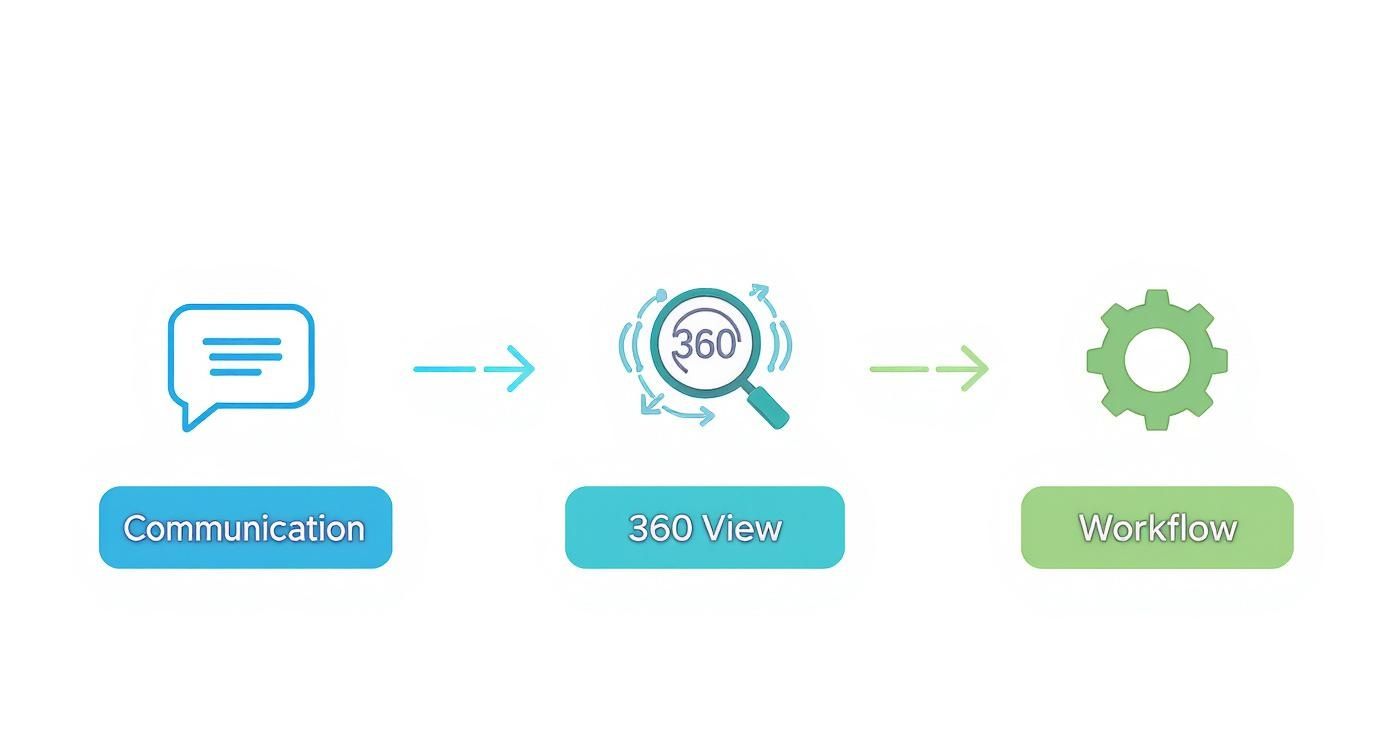
As you can see, each step flows into the next, creating a supportive, seamless experience that builds the kind of trust that lasts a lifetime.
Fostering Enthusiastic Adoption
Here’s the truth: the biggest hurdle in any CRM rollout isn't technical, it's human. The ultimate success of your new system comes down to how enthusiastically your staff adopts it. From day one, you have to frame the CRM as a tool that makes their jobs easier and more fulfilling, not just another piece of software to learn.
Focus on transparent communication, invest in great training, and be sure to celebrate the small wins along the way. Show your team exactly how the CRM cuts down on administrative headaches, freeing them up to focus on what they do best: caring for patients. When your staff starts to see the CRM as a powerful ally in their mission, that's when you'll know you've truly succeeded.
At PYCAD, creating these kinds of connected healthcare ecosystems is what we do. We build custom web DICOM viewers and integrate them into medical imaging web platforms, directly linking critical clinical data into the CRM to empower your care teams. Take a look at our portfolio to see how we bring it all together.
The Future of Care with AI and DICOM Integration
When we look to the horizon, the true potential of customer relationship management in a hospital is genuinely inspiring. We're moving past simple task automation and into a new age of healthcare—one that's predictive, proactive, and profoundly personal. This is where advanced technologies like artificial intelligence (AI) and specialized integrations start to build a system that doesn't just react to patient needs but actually anticipates them.
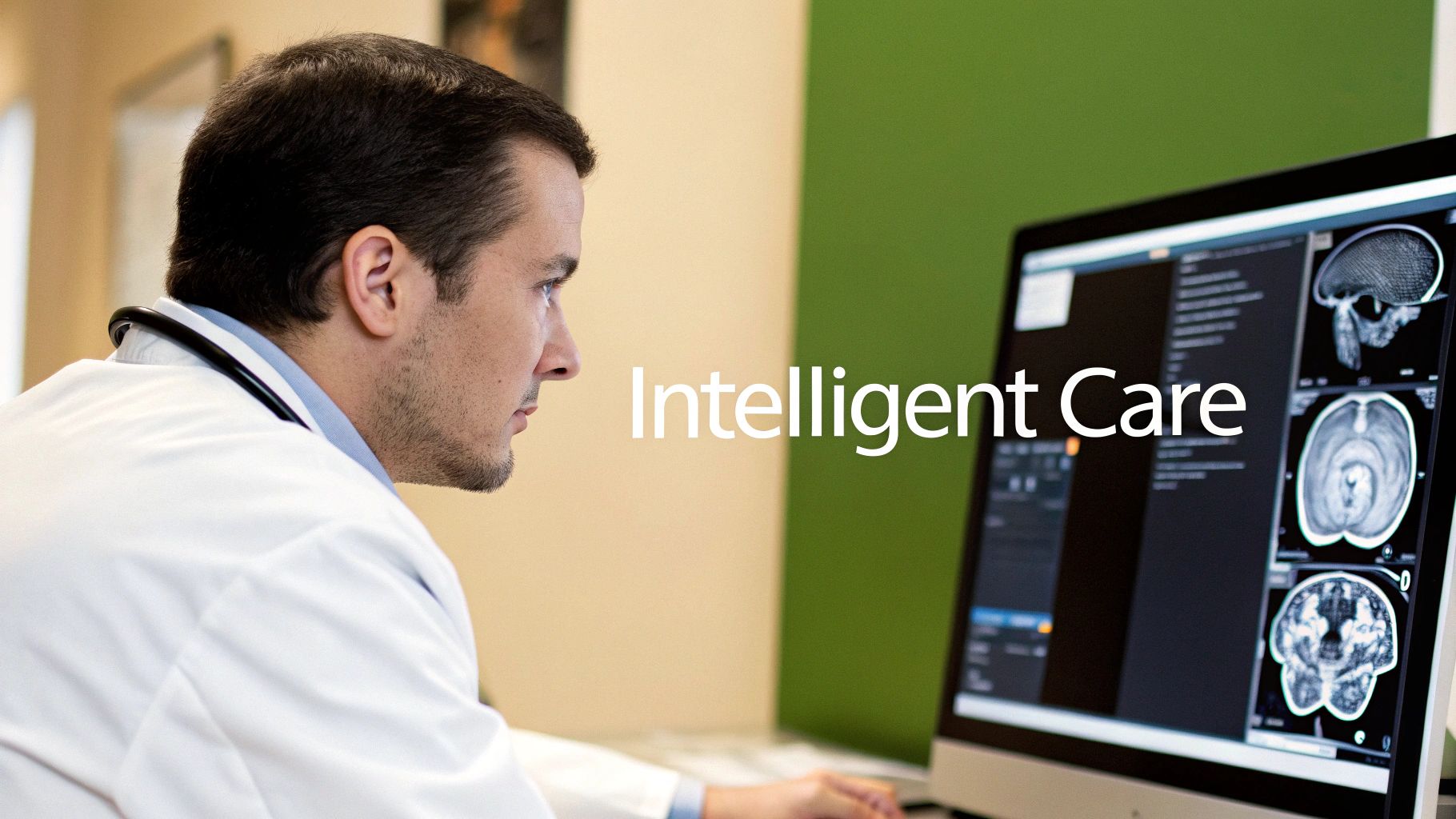
Think about a hospital CRM infused with predictive analytics. A system like this could spot patients at high risk for readmission by picking up on subtle patterns hidden in their health data. Long before a crisis hits, the CRM could trigger personalized outreach, maybe a telehealth check-in or a visit from a home health nurse. Just like that, reactive care becomes proactive support.
The Power of Artificial Intelligence in Patient Relationships
AI is the engine that turns a CRM from a simple database into an intelligent care partner. It sifts through mountains of data—from clinical notes to patient emails—to uncover insights a human could never find on their own. This intelligence shows up in some incredibly powerful ways.
For instance, using AI for data entry, like with AI-powered medical transcription solutions, helps streamline clinical documentation. This ensures rich, accurate patient information flows directly into the CRM, making it instantly available and useful for the entire care team.
AI's true gift to healthcare isn't just its processing power; it's the ability to add context and foresight to every patient interaction, making care more empathetic and effective.
This growing capability is a huge reason why hospitals are leading the charge in adopting CRM technology. In fact, hospitals accounted for about 56.58% of the global healthcare CRM market revenue in 2024. Their complex workflows and the sheer volume of patients make this kind of intelligent management essential, a need that only grows as more procedures shift to outpatient settings.
Bridging Clinical Data and Patient Care with DICOM
One of the most exciting frontiers is the direct link between medical imaging data and the patient relationship platform. This is where clinical findings and patient care finally merge into one seamless workflow. The universal standard for medical imaging is DICOM (Digital Imaging and Communications in Medicine), and connecting it to a CRM is a complete game-changer.
At PYCAD, this is precisely our expertise. We build custom web DICOM viewers and integrate them into medical imaging web platforms, forging that seamless connection to empower healthcare providers. This vital link allows a CRM to act on clinical findings the moment they appear.
Imagine this real-world scenario:
- A patient has an MRI for chronic back pain.
- The DICOM images are analyzed, revealing a condition that needs a specialist.
- The integrated system instantly flags this result right in the patient's CRM profile.
- The CRM then automatically triggers a workflow to schedule a follow-up with the right specialist and sends the patient educational materials about their diagnosis.
This automated, intelligent response closes the gap between diagnosis and action, ensuring no patient ever falls through the cracks. It’s a massive leap forward in creating a truly responsive healthcare journey. For anyone curious about the technical side, you can learn more about https://pycad.co/pacs-integration/ to get a deeper understanding.
By weaving together AI-driven analytics with direct DICOM integration, the future of customer relationship management in hospitals isn't just about efficiency—it's about building a smarter, more compassionate, and life-saving ecosystem of care.
Let's Build a Truly Patient-First Hospital, Together
Making the leap to a hospital CRM isn't just about adopting new software. It's a fundamental commitment to putting your patients at the heart of everything you do. It’s a promise to build a system that deepens trust, opens up communication, and genuinely improves lives.
We've walked through it all in this guide—from the basic idea of a CRM to a future where AI and powerful integrations are completely reshaping the patient experience. Now, it's about making that future a reality.
Bringing Your Connected Vision to Life
The road from vision to reality is paved with partnership. You can't just install a CRM and hope for the best. You need a team that gets the nuances of healthcare—the complex data, the delicate clinical workflows, and the absolute necessity of clear patient communication.
This is what turns a list of features into a living, breathing ecosystem that empowers your staff and supports your patients every step of the way.
The right technology partner doesn't just hand you a piece of software. They help you build a more connected, compassionate, and effective future for patient care, turning your patient-first vision into an everyday operational reality.
At PYCAD, this is exactly what we live for. We specialize in creating these kinds of custom solutions. We build custom web DICOM viewers and integrate them into medical imaging web platforms, bridging the gap between deep clinical insights and the complete patient journey. Our entire focus is on building tools that empower you to deliver a more personal and responsive standard of care.
We’re here to help you build that future. To see how we’ve helped other healthcare organizations bring their vision to life, I invite you to explore the projects in our portfolio.
Frequently Asked Questions
It's only natural to have questions when you're thinking about something as important as how your hospital connects with patients. The shift toward using CRM in healthcare is a big one, and getting clear on the details is the first step toward seeing the incredible potential. Let's dive into some of the most common questions we hear from healthcare leaders.
Think of this as a conversation starter—a way to clear up the common sticking points and reinforce the central idea: building a truly patient-first healthcare experience.
How Is a Hospital CRM Different from an EHR?
Great question. Think of your EHR (Electronic Health Record) as the patient's clinical biography. It’s a meticulous record of their medical story—diagnoses, lab results, treatments, the works. It's all about what happens to the patient medically.
A hospital CRM, on the other hand, is the patient's relationship diary. It tracks every touchpoint—every phone call, email, bit of feedback, and even their communication preferences. It’s all about building a human connection with the patient. One system is for treatment; the other is for trust. They don’t compete; they complete the picture.
Can a Smaller Clinic Benefit from a CRM System?
Absolutely. In fact, for a smaller practice, a CRM can be a game-changer. It’s not just a tool for massive hospital networks. Imagine automating all your appointment reminders, sending out targeted wellness tips to specific patient groups, or systematically collecting feedback to improve your service. That's what a CRM does.
For a smaller team, this is huge. It takes the repetitive, administrative weight off your staff's shoulders, freeing them up to focus on what they do best: caring for people. It’s how you build the kind of deep-rooted patient loyalty that helps a local clinic not just survive, but thrive.
What Is the Biggest Challenge of CRM Implementation?
You might think it's the technology, but it’s almost always the people. The single biggest hurdle is cultural. It's about getting everyone, from the front desk to the clinical staff, to see the CRM as an ally—a tool that makes their jobs easier and more meaningful—not just another piece of software to learn.
Getting this right comes down to leadership and bringing your team along for the journey. When people see how it reduces their busywork and directly leads to happier, healthier patients, that's when the magic happens.
The key is to involve your staff from day one. When they have a hand in the process and can see that the system is designed to serve them, adoption isn't just a requirement; it becomes an enthusiastic choice.
At PYCAD, we live and breathe this stuff. Our specialty is bridging the gap between complex clinical data and smooth patient experiences. We build custom web DICOM viewers and integrate them into medical imaging web platforms, making sure everything works together in perfect harmony.
If you’re curious to see how we tackle these kinds of integrations, take a look at our work over at our portfolio.

